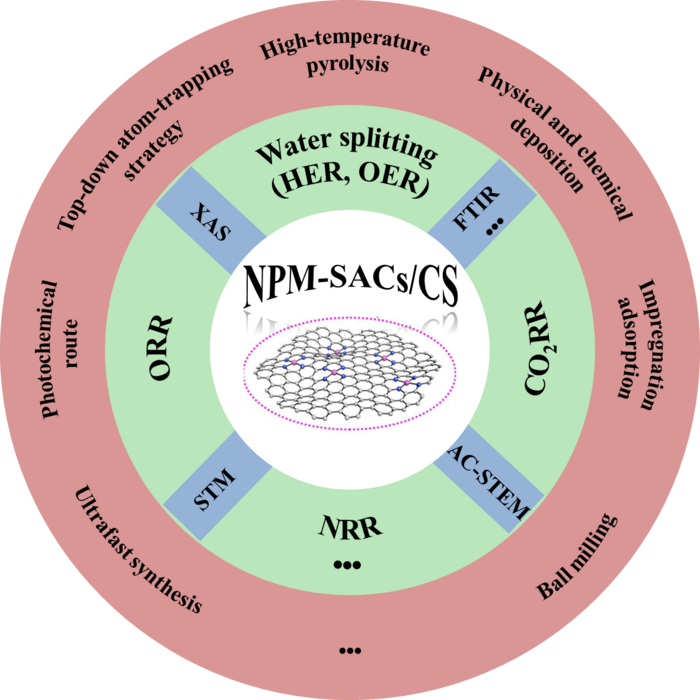A recent review guided by Prof. Yuehe Lin (Washington State University), Prof. Welei Zhu (Nanjing University), and Prof. Yuanyuan Wang (Nanjing University) offered an overview of the advancements in non-precious metal single-atom catalysts (NPM-SACs) for the electrocatalytic field.

The red outer ring represents the synthesis method of the catalyst, the green inner ring represents the catalytic application, the blue matrix represents the characterization technique, and the white inner circle represents NPM-SACs/CS. Image Credit: Art by Yangyang Ding.
Because of their low cost, high performance, and high atomic utilization, NPM-SACs with distinctive electronic structures and coordination environments have received a lot of attention in electrocatalysis. Because of the carbon substrate’s large surface area, outstanding electrical conductivity, and high chemical stability, NPM-SACs on carbon support (NPM-SACs/CS) are enticing.
The researchers introduced some commonly used methods, like physical and chemical deposition, high-temperature pyrolysis, impregnation adsorption, and so on. They also gathered some other new and novel ultrafast synthesis methods that had recently been reported.
Investigators employed scanning tunneling microscopy (STM) and aberration-corrected high-angle annular dark-field scanning transmission (AC HAADF-STEM) for morphological observation, X-Ray absorption spectroscopy (XAS) for atomic structure and electronic property studies, and other specific characterizations for auxiliary analysis.
The group then outlined strategies for optimizing the NPM-SACs/CS macro- and micro-environment. Modifying the coordination number of a nitrogen atom, constructing non-nitrogen heteroatom coordination, tweaking the carbon basal plane, and constructing bimetallic sites are all part of the microenvironment.
In addition, the team provided a comprehensive overview of recent advances in developing NPM-SACs/CS for important electrochemical reactions such as hydrogen evolution reaction (HER), carbon dioxide reduction reaction (CO2RR), oxygen reduction reaction (ORR), oxygen evolution reaction (OER), and nitrogen reduction reaction (NRR).
Finally, the investigators discussed the current problems and potential opportunities of NPM-SACs/CS in the electrocatalytic field, including the control synthesis of high metal loading NPM-SACs/CS, the development of sophisticated single-atom characterization techniques, the investigation of the structure-activity relationship of NPM-SACs/CS for electrochemical reactions, the construction of new coordination environments to enhance catalytic performances, and the improvement of catalytic performances.
Journal Reference
Liu, L.-X., et al. (2023) Recent advances in carbon-supported non-precious metal single-atom catalysts for energy conversion electrocatalysis. National Science Open. doi.org/10.1360/nso/20220059.